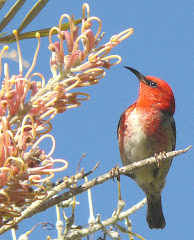 photo from www.treknature.com
photo from www.treknature.comMilly occasionally picks up leeches, and when they've had their fill, we trace a mini trail of blood across the floor or patio, to a happy, plump, soporific fat little leech which (Buddhists don't read on) I throw either into Hell Fire, or into Alternative Leech Hell: a little can of rock salt.
These small creatures (annelids to be precise) are attracted to body heat - miniature heat seeking missiles - they are relentless. Once attached, they have amazingly powerful suction pads and trying to disengage them can be a surpisingly difficult (elastic) experience. Especially if you are phobic of worms - as my poor sweet wife is. Often you don't feel a thing - the leech has already departed leaving only the tell-tale bleeding puncture.
www.treknature.com: the blood-sucking Australian Land Leech (Gnatbobdellida libbata) is found in the moist rainforests and wet eucalypt forests of eastern Australia. When conditions are suitable (moist ground conditions), these relatives of the worm come out onto bushwalking and animal tracks and wait, ‘standing’ in an upright position, clasping the ground with their posterior sucker. Chemical sensors and vibration are used to detect an approaching host, usually native mammals or humans. As the unsuspecting victim moves past they reach over and attach themselves with their anterior sucker; they make their way to a suitable vein near the surface, often around the ankle, upper foot or between your toes. Making a V-shaped incision, blood is prevented from clotting via an anticoagulant and a histamine with improves blood flow directly into the leech. Once attached the leech with fill-up with blood, perhaps tripling its size. When satisfied they drop off the victim and find a suitable niche to digest their meal.
Leeches are most active when the days are really damp. Ticks, however, are more of a constant every day battle, rain or shine. Little Millikins (fondly named by the Southern Hemisphere Martins) requires a daily tick check, despite being safeguarded with either Front Line or a tick collar. Her nether regions are a favourite hideout for these 8 legged little critters - we've never been so close to our dog and she has got used to the check up and all the extra grooming. Most ticks we've found have measured as little as 0.5mm - although the largest we've found has been 6mm. I 've heard they can get up to 20mm - whoopee.
 We operate a tick kit, consisting of a jar, a pair of tweezers, and a highly effective invention called The Tick Twister, which does exactly what it says on the packet - twists the tick off, whilst not aggravating it to inject poison. The jar also contains (my) collection of ticks. Dead ticks. Nice.
We operate a tick kit, consisting of a jar, a pair of tweezers, and a highly effective invention called The Tick Twister, which does exactly what it says on the packet - twists the tick off, whilst not aggravating it to inject poison. The jar also contains (my) collection of ticks. Dead ticks. Nice. We are yet to identify the infamous Paralysis tick from amongst the various local species - but I reckon there's more than one in the photo above. Incidentally, local hearsay is that aboriginal people avoided this area because of the high number of ticks. But don't let that put you off visiting...by the way insect repellents do work, we just keep forgetting to put them on. And in the long term we should build up immunity.
We are yet to identify the infamous Paralysis tick from amongst the various local species - but I reckon there's more than one in the photo above. Incidentally, local hearsay is that aboriginal people avoided this area because of the high number of ticks. But don't let that put you off visiting...by the way insect repellents do work, we just keep forgetting to put them on. And in the long term we should build up immunity.And as for bloody termites... 4 years ago I stored a pile of beeaauuddiful red mahogany floorboards in my parental "out-law's" metal shed, 12kms down the road - a safe bet, you'd think, from any wood munching critters. Lo and behold, what should develop in their woodstack just
 outside, but a dreaded termites nest. Somewhat surprisingly attracted to the metal shed, the little buggers trail in across my timber, leaving all sorts of messy bits in their wake and devour Len's soft wood stacked beneath - see photo. A lucky escape for our timber - just 4 inches of the mahogany was feasted upon - from 275 metres of the stuff. Len and Kay are surprisingly calm, given that all the aluminium joinery within their steel house is in fact fixed with termite tempting timber. Life in the bush sure keeps you on your toes...
outside, but a dreaded termites nest. Somewhat surprisingly attracted to the metal shed, the little buggers trail in across my timber, leaving all sorts of messy bits in their wake and devour Len's soft wood stacked beneath - see photo. A lucky escape for our timber - just 4 inches of the mahogany was feasted upon - from 275 metres of the stuff. Len and Kay are surprisingly calm, given that all the aluminium joinery within their steel house is in fact fixed with termite tempting timber. Life in the bush sure keeps you on your toes...
Len, Tam & Kay loading the mahogony onto the co-op trailer to be towed up to our house, 12km up the road.















I have just removed my second tick this season so I sympathise with your bug trials from a position of (albeit a much smaller European style) experience. We have to watch for Lymes disease here, an infection carried by deer ticks which can be very serious if left untreated. The deer ticks favour long grass and woodland- just like ours in fact! If we had leeches though my daughter would NEVER visit!
ReplyDeleteBest wishes, big love as always
G x